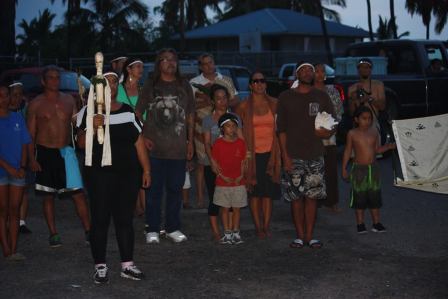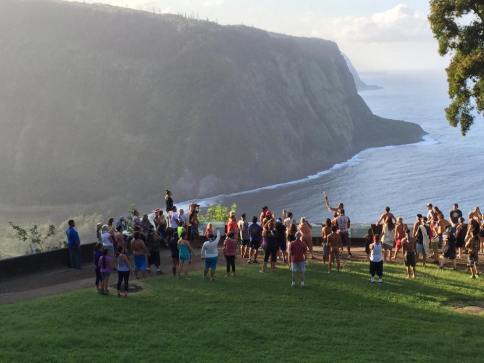It’s been more than two weeks since the Aha Pule ‘Aina Holo (a prayer moving throughout the land). If you didn’t hear about it in time to participate, don’t worry. Lanakila Mangauil will organize this run around the whole island again next year. For those who missed it, here’s a peek at Lanakila’s favorite memories from the inaugural run, and for those who participated, a chance to relive it one more time.
Day 1, November 20. 5:15 am – Opening ceremony at Honoka‘a Park. (See Early Morning Pule Starts the Makahiki Run.)
Lanakila reincarnated this ancient Hawaiian celebration of the Makahiki season, into a prayer run for everyone to join; a run to focus healing energy on the ‘āina and the people who live here.
The first leg of the journey took the runners directly into rain along the Hāmākua coast. KAPA radio provided us with our first social media view of their progress. Hualalai, carrying the Lono staff, ran beside two members of the Pitt River Nation carrying their ceremonial staffs brought from California. A big ‘Thank You’ to KAPA Radio for publicizing the event.
In Hilo, members of the Royal Order of Kamehameha I greeted them in front of the Kamehameha Statue downtown. The Royal Order of Kamehameha carries on traditions and upholds practices to preserve Hawaiian culture. They typically represent the order of the King at special events. So the runners felt especially honored by the recognition of these respected community leaders.
On they ran. Using relays, the runners covered 73 miles, reaching Volcano as planned. Joined by the people who drove supplies and relayed the runners, they sat down to a feast with the help of a Hilo friend, Kaleinohea and her ‘ohana, who brought a special medicinal soup.
Day 2, November 21. Rising at 5 am, the group gathered along the Kilauea Caldera at Volcanoes National Park for another dawn pule, this one honoring Pele. It was still quite dark, so the red glow in the Halema‘uma‘u Crater was clearly visible – the home of Pele, the great womb where new land originates. Lonomakua was her uncle, and trained her in the gift of fire, so it was very appropriate to bring this Lono staff to the edge of the caldera for prayers.
Kaleinohea and another Hilo woman took Lono on the first leg this morning. Today’s goal was to swing through Na‘alehu, the southernmost town in the United States and up the west coast to Miloli‘i, 33 south of Kona. As they progressed down the mountain, the runners continued to relay and eat the medicine soup. The organizers promoted the conscious choice of locally grown organic food, and Hawaiian foods when possible throughout the run, an important part of honoring the health of the ‘āina and the people.
When they passed the black sand beach of Punalu‘u, Lanakila wanted the Pitt River guests to experience it. Luckily, the group had been joined by three young men from Puna and two others who volunteered to keep going with Lono. These five relayed seven miles down the stretch into the little town, a far cry from the normal group of 30 with their five relay vehicles.
Before the run, Lanakila had reached out to people in each community they’d pass through to get the word out and encourage participation. But he was able to contact only one aunty in Kau, who hosted them at lunch in the local park. Vast, rural, remote and few people – that’s how writers describe this district, the southern-most part of the Big Island. Yet it manifested that they were able to connect with a large group of Kau elders who were attending a bingo party and lunch in town. These kupuna had seen the runners on their way to the party, and wondered what was going on. Never shying away from an opportunity to share his vision, Lanakila told them about the Aha Pule ‘Aina Holo. The kupuna greeted the news with applause and awe for the respect their heritage was receiving once more. And following Hawaiian familial customs he honored these kupuna with a group chant when the rest of the runners caught up with him.
By the end of Day 2, they ran an additional 62 miles, and were warmly welcomed by the Miloli‘i community, the “last Hawaiian fishing village,” who publicized the prayer run and took responsibility for a section of the next day’s journey. The runners relished the feast they provided. One Pitt River woman kidded at the closing ceremony that they consider their own land a grocery store – food everywhere if you know where to look. “But in Hawaii, you have a super-market! So many wonderful foods, right along the road! You are blessed with abundance.”
Day 3, November 22. The road is treacherous along the next stretch of highway around the Big Island. So keeping safety in mind, Lanakila asked people to canoe the Lono by ocean on this leg of the journey. Led by Pa‘a Pono Miloli‘i, and joined en route by three more canoes from nearby communities of Ho’okena and Honaunau, they embarked on a 21 mile paddle from Miloliʻi to the Place of Refuge (Hale O Keawe at Puʻuhonua O Hōnaunau).
At 5:15 am, more than 60 people participated in a formal ceremony as Lanakila lashed the Lono to the Miloli‘i canoe. Eighteen paddlers and an escort boat set out. At Hōunaunau, Lanakila performed protocol and the group acknowledged the site where the bones of an important Ali‘i, Chief Keawe, had been kept.
From there it was a 6 mile paddle back out into the ocean and over to the next bay, Kealakekua. This was the traditional site where Lono was said to come ashore during the Makahiki, bringing rain to renew the land. Greeters from Kealakekua waded into the water to accept Lono and swim the staff to shore, where it was passed to caretakers of Hikiau Heiau for its entrance into sacred grounds. One of the caretakers, a mo‘olono (priest), told Lanakila, “You know you started something here. You’re going to have to do this again next year.”
“That was my intention,” he replied.
By the time the group got back out to the main highway, 25 runners from Kona and Honoka‘a had joined them, and they ran straight down Kuakini Road into Kailua-Kona. Here they stopped for protocol at two other important historical sites. At Hulihe‘e Palace, the summer palace of the king, they greeted the docents and exchanged chants. From there it was a short run along the seawall on Ali‘i Drive to Ahu‘ena Heiau outside of the King Kamehameha Hotel. With conch shells blowing all the way, they treated tourists to quite a spectacle. But they didn’t pause – they were on a mission.
The group rested for lunch at the old Kona airport, now a park. Uncle Ku Ching, a respected Hawaiian elder from Waimea, joined the group and then took the Lono as the group set out again. It meant a lot to Lanakila to have this kupuna’s blessing.
The runners reached their goal of making camp next to Pu‘ukolola Heiau National Historic Site, though they ran the last 10 miles in the dark along the busy Queen Ka‘ahumanu Highway. They traveled a total of 72 miles on Day 3, 27 miles of it by water.
Aunty Kalaokahaku Akima, who cares for the Pu‘ukololā Heiau, ran the Lono up to the park gates. There the Akau ‘ohana received the Lono and led the procession to the ceremonial grounds behind the heiau, chanting the whole way.
After a day of running, Lanakila had to immediately change and hula! The halau he belongs to, led by his kumu, Kuwalu Anakalea, danced to celebrate. The Pitt River Indians also shared their ceremonial rites, a treasured cultural exchange through dance.
 Day 4, November 23. They were finally on the home stretch, but not before heading up to Hawi and beyond to the statue of King Kamehameha at Kapa’au, greeted by people of Kohala. One of the Solomons, a respected Hawaiian family from Kohala, carried the Lono to the foot of the statue. While performing protocol, Lanakila turned around and saw his family: mom, sisters, brother-in-law and nieces and nephews, who joined the run there, and continued all the way to the end.
Day 4, November 23. They were finally on the home stretch, but not before heading up to Hawi and beyond to the statue of King Kamehameha at Kapa’au, greeted by people of Kohala. One of the Solomons, a respected Hawaiian family from Kohala, carried the Lono to the foot of the statue. While performing protocol, Lanakila turned around and saw his family: mom, sisters, brother-in-law and nieces and nephews, who joined the run there, and continued all the way to the end.
As the runners came into Waimea, it seemed that the whole community turned out. They marched the Lono around the Manaua, the rain rock where generations of Hawaiians prayed for Waimea rain. Later at the Immersion Preschool, every preschooler, many in malo (loincloth), carried the Lono for a few feet. Their parents ran it out of Waimea, detouring off the highway onto Mud Lane. While most of this road is not passible by car, it can be hiked, exiting close to Waipi‘o Lookout.
On the other end of Mud Lane, the aunties of Kukuihaele picked up the Lono staff and later passed it to a dozen young Waipi‘o and Honoka‘a Hawaiian men. It was an important symbolic moment, because some of these young men had direct ancestral ties to Umi, the first King to unite the people on the Big Island. (See Waipi‘o – Valley of the Kings.) They carried Lono to Waipi‘o Lookout, where Lanakila talked to them about responsibility, and then through Kukuihaele village. Back on the main highway, about 150 people joined the run.
Now it was time for the final push back into Honoka‘a. Just outside town, they regrouped one more time before entering Honoka‘a Park, back to the bamboo banner at the run’s starting point. Lanakila chose a different path to approach it. “Because this run was something new, like a new birth, I wanted to acknowledge it by coming in from the east, like a new sunrise.”
 They reached the park about 5:30 pm on Day 4, a clockwise route around the island of 252 miles. At the park, we gathered for the closing ceremony, prayers, and heartfelt “thank you’s” to the Pitt River Indians who inspired Lanakila and raced the entire route. We were all feeling great, whether we ran, drove the relay cars, provided housing, gas money and food, or cooked for the celebrations. Lanakila acknowledged our feelings and at the same time, challenged us. “Now we have a choice to make. Do we just enjoy the moment or attempt to create permanent change?
They reached the park about 5:30 pm on Day 4, a clockwise route around the island of 252 miles. At the park, we gathered for the closing ceremony, prayers, and heartfelt “thank you’s” to the Pitt River Indians who inspired Lanakila and raced the entire route. We were all feeling great, whether we ran, drove the relay cars, provided housing, gas money and food, or cooked for the celebrations. Lanakila acknowledged our feelings and at the same time, challenged us. “Now we have a choice to make. Do we just enjoy the moment or attempt to create permanent change?
“What is going to make this real and make it continue is that we truly make it a part of our spirit again. These days our spirit is governed by money. We don’t follow the right timeline – we aren’t connected to nature and the seasons and the ‘āina anymore. We identify and complain about all our problems, but what are we doing about them? We can’t just pray. We have to act. We have to bring the physical act of doing into our prayers.
“These brothers and sisters from the Pitt River Nation understand that idea. They run every year in their prayer ceremony from one sacred mountain to another. When they heard about our run, they held yard sales and raffles, and in one month, they found the money to send these 20 people to support us. They have family. They have jobs. They have lives of their own. But they made the time to be with us.
 “Let that inspire us to action. We have no excuse for not participating. We consciously conducted this ceremony in a way in that engaged our physical presence; in a way that forced us to see our land and check on the health of our ‘āina. And beyond that, the health of our land is the health of our people. Pray for the land. Give conscious though to eating healthy. Physically connect to our ‘āina again. Be ready to participate next year.”
“Let that inspire us to action. We have no excuse for not participating. We consciously conducted this ceremony in a way in that engaged our physical presence; in a way that forced us to see our land and check on the health of our ‘āina. And beyond that, the health of our land is the health of our people. Pray for the land. Give conscious though to eating healthy. Physically connect to our ‘āina again. Be ready to participate next year.”
 Finally, Lanakila disclosed that lots of people asked, “What makes Honoka‘a so special that you started and ended the Makahiki run there?”
Finally, Lanakila disclosed that lots of people asked, “What makes Honoka‘a so special that you started and ended the Makahiki run there?”
He replied, “What’s not special about Honoka‘a?” We roared our approval, and made our way to the Honoka‘a People’s Theatre for one last Makahiki feast, until next year’s Aha Pule ‘Aina Holo.
(Note: I did my best to track down the photographers for these photos taken from FB but some had been reposted without credit. Please help me find the photographers for the pictures that say “unknown” and let me know if I have made mistakes.)
For other essays on the Makahiki Pule ‘Aina Holo see:
Makahiki – new twist on an old tradition
Early morning pule starts the Aha Pule ‘Aina Holo
If you like my blog, you’ll enjoy my book, Manifesting Paradise, available on Amazon. Receive my posts automatically by filling in your email address in the “follow” box at the top of the right column. And please join my mailing list.



















Lono is supposed to be facing the agricultural lands. Where is he facing?
Perhaps with more events like this we will have more land in pono agricultural use. It surprises me too that only 4% of the Big Island’s agricultural land is actually planted in agriculture. But everyone can have a garden, even if it’s just a pot of herbs on a windowsill of a rented apartment.
Pingback: Early morning pule starts the Makahiki run | Manifesting Paradise
Pingback: Makahiki – a new twist on an old tradition | Manifesting Paradise